From Sacred Soils to Shared Tables: On the Resilience of the Maize Plant
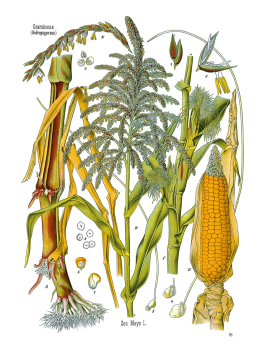
Maize is a symbol of life—of sustenance, tradition and a deep connection to the land. Rooted in the sacred soils of what is now Mexico, Maize was first domesticated about 7 to 9.000 years ago by Indigenous farmers including the Maya, Aztec, and Olmec. For these cultures maize was life itself, honored in art, myths and rituals. It was sacred and central to the understanding of life's cycle, from birth to death to rebirth. In the sacred book of the K’iche’ (one of the Maya peoples), the Popol Vuh, humans are described as being created from maize (the mother) itself, reflecting its fundamental role in their culture.
The transformation of one of the ancestors teosinte, a wild grass, into maize was one of the greatest agricultural achievements in history. It enabled civilizations to thrive and cities to rise. Teosinte looked nothing like the maize we know today—it had small, spaced-out kernels encased in hard shells. And unlike its wild ancestors, modern maize cannot survive without cultivation and care.
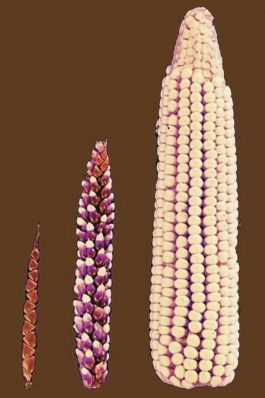

While there are over 50,000 edible plants on Earth, just 15 of them provide 90% of the world’s food intake. At the heart of it: rice, wheat and maize.
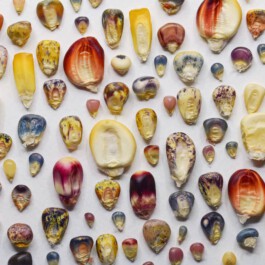
Sustaining Cultures
Today, maize is one of the most widely grown crops on Earth, with over a billion tons produced each year. Yet most of it never reaches a plate. Instead, it’s used for livestock feed, ethanol production, and countless processed products—from corn syrup and starch to bio-plastics. While industrial production focuses on just a few commercial types, maize itself is incredibly diverse, types cultivated and preserved around the world—including over 28,000 unique collections in germplasm banks. These include stunning examples like the multicolored glass gem, with its translucent, rainbow–kernels. The vibrant colors—deep red, blue, purple, yellow—are the result of centuries of Indigenous seedkeeping. They are natural plant pigments: Anthocyanins for example give red, purple, and blue tones, Carotenoids give yellow and orange tones.
The varieties are broadly classified by kernel types:
〇 Sweet corn (eaten as a vegetable)
〇 Popcorn (popping when heated)
〇 Dent corn or field corn (animal feed and processed foods)
〇 Flint corn (polenta)
〇 Flour corn (soft milling and tortillas)
〇 Waxy corn (cornstarch and industrial uses)
Maize first spread across the Americas, sustaining cultures from the Mississippi of North America to the Inca of the Andes, each adapting it to their unique ecosystems and ways of life.
With the arrival of Spanish colonizers in the 15th and 16th centuries, maize was introduced to Europe, Africa, and Asia as part of the Columbian Exchange, a forced and violent transfer of plants (including crops like potatoes, tomatoes, and cacao), animals, people, and diseases between continents. As it was spread, maize adapted to new lands and was transformed to polenta in Italy; to ugali and sadza in East and Southern Africa (which were traditionally made with grains like millet and sorghum); to proja in the Balkans (where I partly grew up) to arepas in the Caribbean or Tacos in Mexico. While maize’s adaptability and resilience allowed it to thrive in many different climates, cultures and cuisines, its global spread ultimately reflects the interwoven legacies of colonial systems that displaced and changed existing foodways forever.
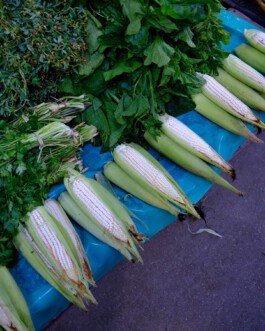

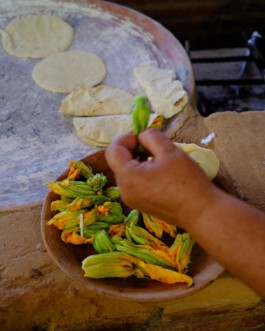
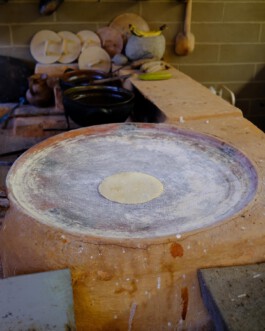
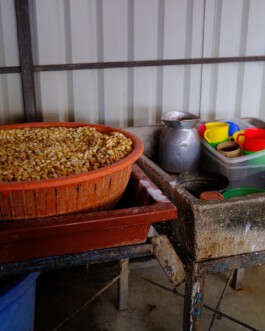
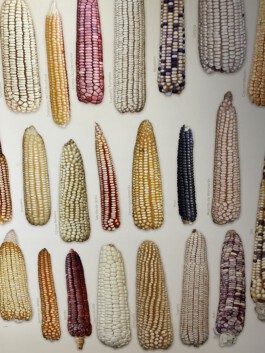
Maize in global cuisines
By the 17th century Maize quickly adapted to various climates and cuisines and became a common staple for many peasant and rural communities worldwide. When traditional crops failed or became inaccessible, maize often emerged as a vital food source in times of agricultural crisis and hardship, sustaining the hungry.
In its many forms, it has played a significant role in shaping identities and nourishing communities across the globe. It has not only provided sustenance in difficult times but also fostered connections between generations and culinary traditions. The legacy of maize in these dishes speaks to the resilience, resourcefulness, and adaptability of the people who have cultivated it.
Cornbread: A Legacy of Resilience, Community and Identity
In the American South, maize was turned to delicious cornbread, a staple in Black culinary traditions, which was born out of necessity and resourcefulness during the time of enslavement and segregation. Enslaved people from Africa, many of whom came from agricultural societies where grain-based food like millet and sorghum (for porridges, breads, and fermented dishes were staples), were forced to adapt to unfamiliar soils and limited ingredients available to them. They knew how to cultivate, grind, cook, and store grains in many different ways and corn, abundant and accessible, and Maize became a vital resource.
Cornmeal was baked into simple, sustaining breads like cornbread, fried into hushpuppies or hoe cakes, and cooked into warm, hearty grits. Cornbread is typically baked in a skillet, giving it a golden crust and dense texture. It can vary sweet to savory, often served with collard greens, stews, fried chicken or chili.
Over time, the dish born from hardship was transformed into something sacred and comforting. It remains a staple served at family gatherings, celebrations, and soul food kitchens, and continues to be a symbol of resilience.
Proja: The Balkan Cornbread
Proja is a simple, hearty cornbread deeply rooted in the agrarian traditions of several countries in the Balkans, a culturally diverse region in Southeast Europe. Made with just few ingredients: cornmeal, water, oil, and salt—sometimes enriched with yogurt or cheese—it’s typically baked thick and served alongside stews, or yogurt. It's a simple, nourishing dish that could be made with minimal resources, often baked in wood-fired ovens or over an open flame. Compared to American cornbread (which is a bit more light / fluffy, and enriched with eggs, butter, or sugar), Proja' more dense and rustic texture reflects the region’s culinary traditions, shaped by resilience and reliance on humble, nourishing staples. To me, it is a symbol of community, survival, and making the most of the land—representing the ingenuity and adaptability of the people who depended on it.
As maize was brought in Europe through the Columbian Exchange—a forced and often violent transfer of crops, animals, people, and diseases—it eventually made its way into the Balkans which were under Ottoman rule at the time. With its resilience, high yields, and long shelf life, Maize became essential for communities facing during harsh times. And proja, initially a dish of survival, reflected the resourcefulness of its people who made most of what they had—an everyday meal that turned necessity into nourishment.
The Three Sisters: Indigenous Wisdom and Sustainable Agriculture
In many indigenous North American cultures, maize was not planted alone—it was part of the Three Sisters: a sophisticated and sustainable agricultural method that paired maize, beans, and squash together, each plant supporting the others in a ecosystem of mutual benefit–just like sisters, growing stronger together.
→ Maize provided a tall stalk for the beans to climb (allowing them to get sunlight).
→ Beans fixed nitrogen into the soil (improving its fertility and ensuring better crop growth).
→ Squash spread across the ground (protecting the soil by shading it with its broad leaves, retaining moisture, and suppressing weeds).
This trio not only maximized productivity but also promoted biodiversity, reciprocity, soil health, and long-term sustainability.
When ceramic vessels were created the Olmec people began cooking maize together with beans, improving the nutritional value of it.
Additionally Indigenous peoples developed a process called nixtamalization, where maize was soaked and cooked in alkaline water made from ash or lime. This not only softened the kernels and enhanced the flavor but crucially made niacin (a vitamin B3) bioavailable—preventing malnutrition diseases like pellagra. The complementary planting of maize, beans, and squash also provided complete proteins when eaten together, the amino acids (that maize alone lacked) balancing one another.
The Three Sisters serve as a good reminder that food systems can be collaborative, rather than extractive, rooted in reciprocity and passed down through generations in close relationship with the land.
"The land is not a resource to be consumed,
but a teacher to be listened to."
–Robin Wall Kimmerer (Braiding Sweetgrass)
Reclaiming the Seed
Maize is one of the most widely consumed crops in the world. From tortillas to cornmeal, grilled corn on the cob to tamales, maize is found in countless culinary traditions.
Today, maize remains one of the world’s most important crops, feeding billions of people and serving as a key ingredient in livestock feed, biofuels, and processed foods. While industrialization has transformed its production, traditional maize-based foods and farming methods continue to be preserved and valued.
Traditional maize cultivation embraces diversity: in Mexico alone, there are over 60 recognized varieties of maize—passed down through generations, each adapted to specific climates, soils, and cultural needs. These native varieties are not just genetic resources—they are expressions of Indigenous knowledge, agricultural skill, and culinary heritage. But the story of maize is also a story of erasure—of seeds, of names, of languages, of Indigenous sovereignty.
Much of today’s maize is genetically modified, with companies like Monsanto/Bayer producing patented seeds that cannot be replanted, tying farmers to dependence and raising urgent questions about seed sovereignty, sustainability, and corporate control and greed over food systems. GM seeds are typically patented by corporations, and the use of these seeds is bound by contracts that legally prohibit saving or replanting them. In some countries, farmers have been sued for patent infringement after saving or even unintentionally growing patented maize. Farmers don’t own these seeds—they essentially have to lease them each season, making them dependent on the corporations that control access.
Modern industrial agriculture has transformed maize into a commodity crop, often grown in vast monocultures that deplete soil health, require heavy pesticide and fertilizer use, and reduce biodiversity. Monocultures built around such seeds erode biodiversity and disconnect communities from traditional farming knowledge. In the U.S. for example, the vast majority of corn grown is not for direct consumption but for animal feed and industrial use—including unhealthy sweeteners like high-fructose corn syrup.
Choosing organic or non-GMO maize products, seeking out local heirloom varieties, and advocating for seed sovereignty can contribute to a more just and resilient food system. Luckily, in response, growing grassroots movements—like La Vía Campesina, led by peasant farmers, seed savers, small-scale producers, and Indigenous communities—fight for food sovereignty to reclaim maize, the Mother of Life, from industrial agriculture. They are working to restore heirloom varieties, protect local seed systems, and advocate for sustainability: honoring diversity, reciprocity, and food justice.
One inspiring example of maize revitalization is Carl Barnes, a Native American farmer and seed saver from Oklahoma, who devoted decades of his life to preserving and sharing traditional maize varieties, including the stunning and beautiful Glass Gem corn. His work highlights how individual commitment can help protect cultural heritage and biodiversity against industrial pressures and corporate control.
Through their hands maize remains what it has always been: not a mere commodity, but a gift—rooted in resilience, community, and care for the land.
Here are 3 delicious ways to enjoy this versatile ingredient:
Recipes:
Grilled Corn with Miso Butter ↗
a pinch of salt
c/o Tamara Pešić
Ludwigstraße 197
63067 Offenbach
Germany
Open on Appointment.
Pickup times:
Thursdays, 16:00–19:00
Saturdays, 13:00–16:00
© 2022
a pinch of salt
c/o Tamara Pešić
Ludwigstraße 197
63067 Offenbach
Germany
Open on Appointment.
Pickup times:
Thursdays, 16:00–19:00
Saturdays, 13:00–16:00
© Copyright 2022